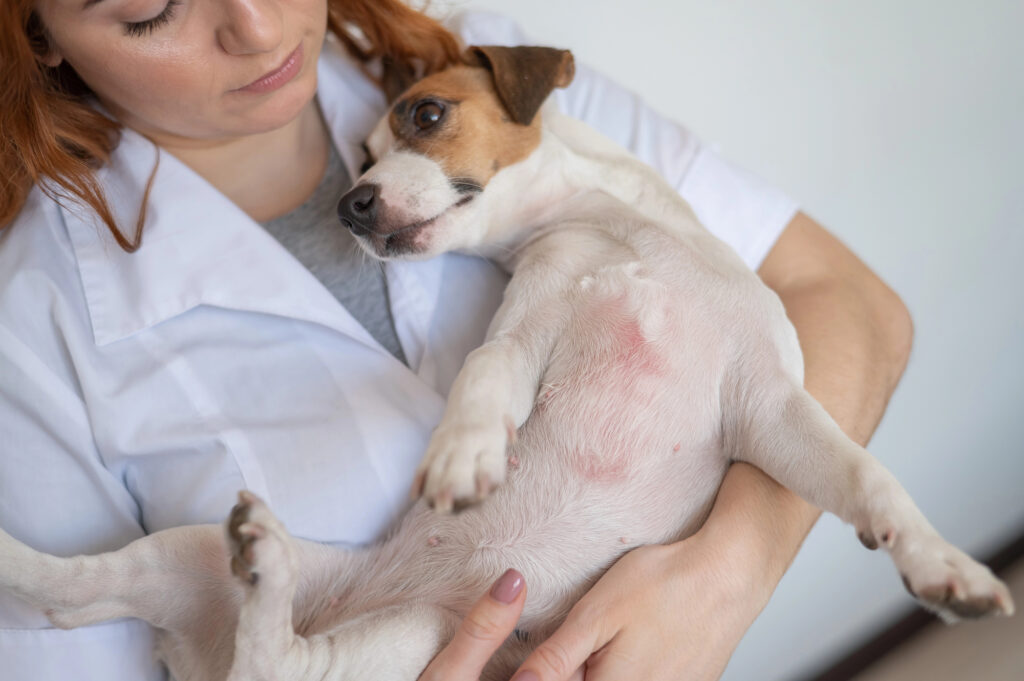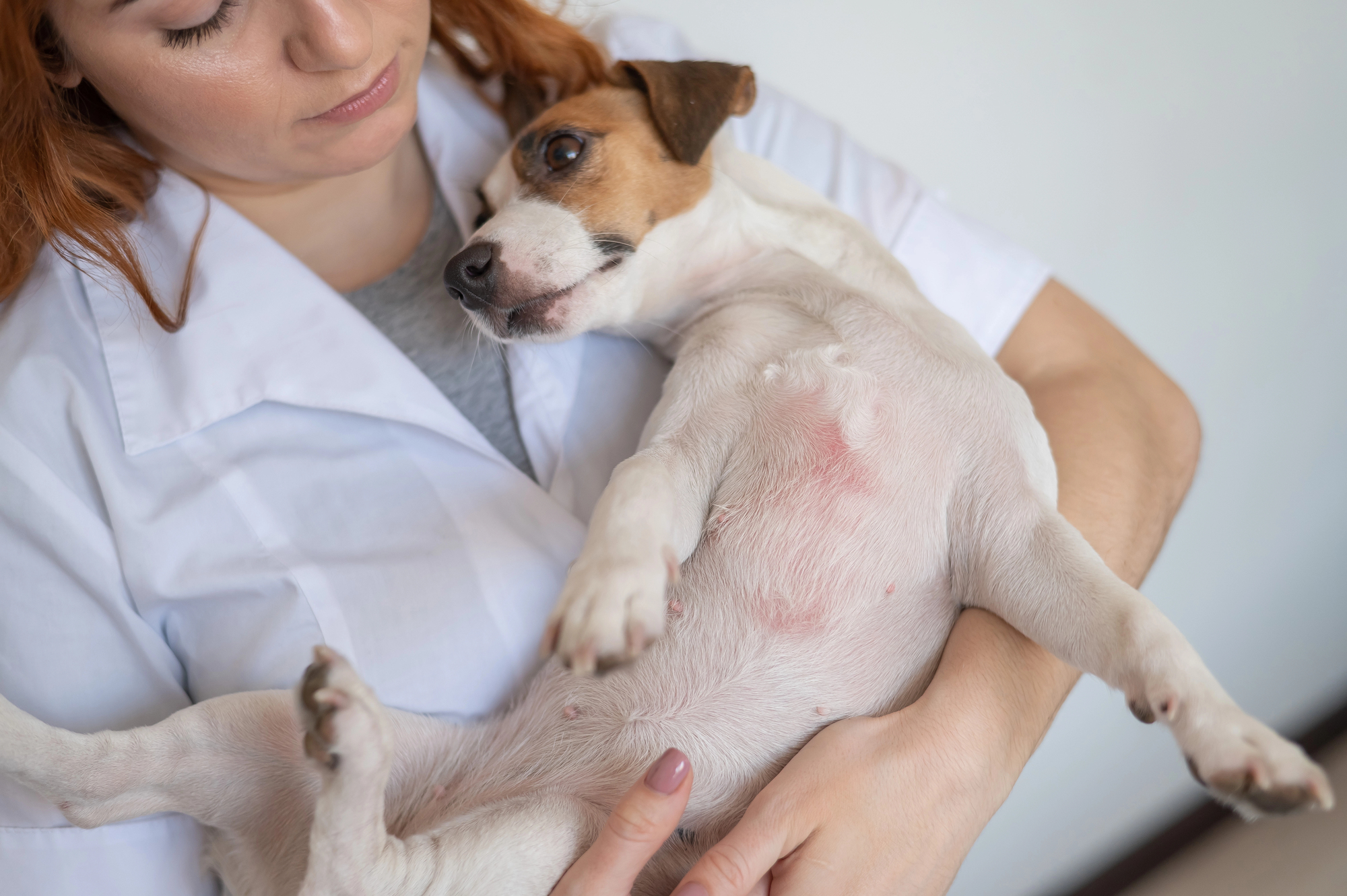
Dog Allergy Testing: When, Why, and How to Help Your Itchy Pup Feel Better
If your dog is scratching non stop, licking their paws raw, or dealing with constant ear infections, allergies might be the reason. Just like us, dogs can react to all sorts of things—from food to pollen to flea bites.
Figuring out exactly what’s causing the itch can feel like chasing your tail, but allergy testing can help point you in the right direction.
Here’s what you need to know to help your pup feel more comfortable and less irritated.

Boarding Clients!*Discount does not apply during holiday/peak rate periods.

Signs Your Dog Might Have Allergies
Allergy symptoms in dogs can look different from one pup to another, but here are some of the most common things to watch for:
- Itchy skin or frequent scratching
- Licking or chewing at paws and legs
- Red or inflamed ears
- Repeated ear infections
- Sneezing or watery eyes
- Vomiting or diarrhea (especially with food allergies)
- Hives or red bumps on the skin
- Rubbing their face on the carpet or furniture
If your dog is dealing with any of these on a regular basis, it might be time to look into allergy testing.
What is the Most Common Dog Allergy?
The most common allergy in dogs is a flea allergy. Even a single flea bite can trigger an intense reaction in sensitive dogs.
This condition is called flea allergy dermatitis, and it causes severe itching, especially around the tail, lower back, and thighs. While food and environmental allergies are also common, fleas tend to be the top culprit. Many dogs with other allergies also have a flea allergy, which can make symptoms even worse if not addressed.
Common Things Dogs Are Allergic To
Dogs can be allergic to all sorts of stuff in their everyday environment. Some allergens come from outside, others from food or even your home.
Here are some of the most common ones:
- Fleas and flea bites– This is the top allergy trigger for many dogs.
- Dust mites and mold spores– Found in carpets, furniture, and humid areas.
- Pollen from trees, grass, and weeds– Seasonal allergies aren’t just a human thing.
- Certain foods– Beef, chicken, wheat, soy, dairy, and eggs are among the most common food allergens found in dogs with ongoing allergic symptoms.
- Household cleaners or grooming products– Some shampoos, sprays, or detergents can irritate sensitive skin.
- Feathers and dander– Including your other pets’ skin flakes or even down in bedding.

Types of Allergy Testing for Dogs
There are two main types of allergy testing for dogs. Your vet will recommend one based on your dog’s symptoms and medical history.
Veterinary Testing
Vets typically use intradermal allergy testing or serum allergy testing.
- Intradermal testingis the gold standard for diagnosing environmental allergies, especially in dogs with atopic dermatitis. After light sedation, a patch of fur is shaved and multiple allergens are injected just under the skin. If a bump forms, it means there was a reaction. This test is usually done by a veterinary dermatologist.
- Serum allergy testinginvolves drawing blood and checking for IgE antibodies that react to specific allergens. It’s less invasive than skin testing and a good option for dogs who can’t be sedated, though not always as precise.
At-Home Allergy Tests
At-home kits use hair or saliva samples you send to a lab. They test for sensitivities, but not true allergies where IgE allergic reactions occur, like those found through a vet’s skin prick test or blood test.
They’re simple and convenient, but not a substitute for a professional diagnosis. It’s best to review any results with your vet to decide on next steps.
How Do Doctors Test for Dog Allergies?
Veterinarians test for dog allergies using either skin testing or blood testing to see how your dog’s immune system reacts to different allergens.
Skin allergy testing, like intradermal testing, involves injecting multiple allergens under your dog’s skin to see which ones trigger a visible reaction. Blood tests check for IgE allergic reactions, which happen when your dog’s immune system creates antibodies in response to certain allergens.
Both methods can help narrow down what’s causing your dog’s symptoms and are usually paired with your dog’s medical history and exam to get a clearer picture.

Is Allergy Testing for Dogs Worth It?
Allergy testing can be worth it if your dog has ongoing symptoms like constant itching, skin infections, or digestive problems that don’t go away with basic treatment. It helps take the guesswork out of what’s causing the discomfort.
Knowing exactly which allergens are causing your dog’s allergic symptoms can save you time, money, and stress in the long run. Instead of trying multiple foods or medications blindly, you’ll have a clear direction. If your dog has an allergic disease linked to environmental triggers, your vet might recommend allergen specific immunotherapy—a long-term treatment that targets the root cause instead of just easing symptoms.
That said, allergy testing isn’t always the first step. Sometimes, your vet will try other things first, like diet changes or parasite control, before recommending a test.
What Age Should You Allergy Test a Dog?
Dogs should usually be allergy tested after they’re at least 1 year old. Testing too early can lead to unreliable results since their immune system is still maturing.
That said, if your puppy is showing serious allergy symptoms, your vet might still run certain tests or recommend a trial treatment plan. For adult dogs with long-term symptoms, allergy testing becomes a more helpful and accurate tool.
How Much Does Dog Allergy Testing Cost?
Dog allergy testing can cost anywhere from $100 to $400 or more, depending on the type of test and where it’s done.
At-home kits tend to be the most affordable option, often landing under $150. Blood (serum) tests done through your regular vet typically fall in the $200–$300 range.
The most expensive option is intradermal skin testing, which usually requires a visit to a veterinary dermatologist and can cost $300 or more—especially if sedation is needed. Some clinics will charge for an initial consult on top of the testing itself, so it adds up quickly.
If treatment like immunotherapy is recommended after testing, expect additional long-term costs. Allergy shots (or drops) often run between $150–$180 per vial, and that’s not including any medication your dog might need to stay comfortable while the treatment starts working.

Treatment Options After Allergy Testing
Once you know what’s bothering your dog, you and your vet can come up with a plan that fits. Here are some common treatment options:
- Allergen avoidance– If possible, avoid the things your dog reacts to, like certain foods or cleaning products.
- Prescription medication– Things like antihistamines, steroids, Apoquel, or Cytopoint can help control symptoms.
- Immunotherapy (allergy shots or drops)– These are made just for your dog based on their test results and help build tolerance over time.
- Flea control– For dogs with flea allergies, consistent flea prevention is non-negotiable.
- Hypoallergenic diets– If food allergies are the issue, your vet may suggest a prescription diet or a strict elimination diet.
- Special shampoos or skin treatments– These can help soothe itchy, inflamed skin while you work on the root cause.
Does Pet Insurance Cover Allergy Testing?
Pet insurance may cover allergy testing if it’s recommended by your vet and not considered a pre-existing condition.
Most insurance companies will pay for testing and treatment as long as the symptoms started after the policy began. That’s why it’s always a good idea to read the fine print or give your provider a quick call to confirm what’s covered. Some plans may even help cover ongoing treatments like immunotherapy or prescription medication.
If your dog has had signs of allergies before you got the insurance, the company might label it as a pre-existing issue—and in that case, you’d be on the hook for the costs. Either way, it’s worth checking before you commit to testing, just so there are no surprises.
Final Tips for Managing Dog Allergies
Allergies aren’t always something you can fix overnight, but with the right steps, you can make life a lot more comfortable for your dog.
- Keep your dog’s living space clean– Wash bedding, vacuum carpets, and dust regularly.
- Stick to a flea prevention routine– Even one bite can trigger a flare-up.
- Use gentle, vet-approved grooming products– Harsh shampoos can make itchy skin worse.
- Watch for seasonal flare-ups– Pollen and mold levels change with the weather.
- Keep a symptom log– Track when things get worse to help spot patterns.
- Work closely with your vet– Especially if your dog needs long-term management or has other health concerns.

Conclusion
Dog allergies can be frustrating—for you and your pup. If you’ve tried different foods, cleaned the house from top to bottom, and your dog is still itching or uncomfortable, it might be time to get to the root of it with allergy testing.
Whether it’s a simple at-home test or a more thorough workup at the vet, knowing what’s causing the reaction is the first step toward helping your dog feel better. With the right treatment plan, most dogs can get relief and enjoy a much calmer, comfier life.
Let your dog do what they do best—play, nap, and just be a happy pup. And if allergies are getting in the way, now you’ve got the info to take the next step.


















